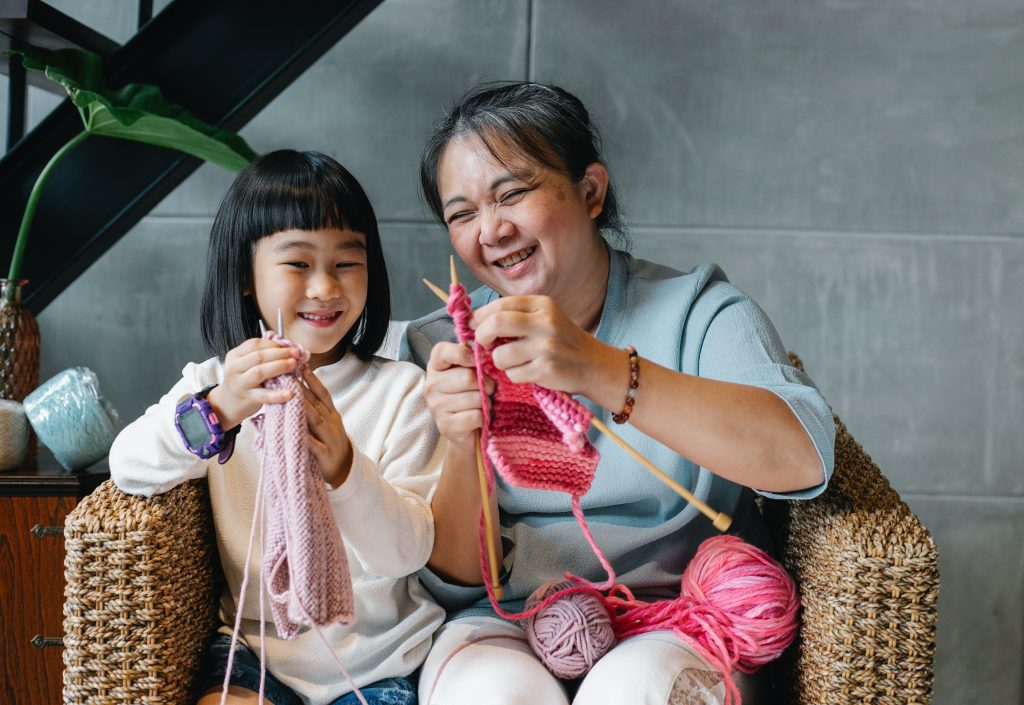8 You’re the Inspiration
Meet Rosalia
“I’m sorry, mom,” Rojelio says to Rosalia as she mops up the remnants of spilled milk from the dinner table. “Don’t worry about it, sweetie,” she replies, placing a gentle hand on his shoulder. “Let’s just be extra careful the next time we don’t have lids on our cups, okay?” Rojelio nods and takes his plate to the sink with a smile. Rosalia thinks back to when she was little and how upset she would get if she spilled her own drink at the table or accidentally broke something in her family home. Instead of yelling at Rojelio for spilling his milk, she tried her best to respond how she would have wanted her parents to respond and it seemed to work well enough. Even though it isn’t always easy to be patient or practice supportive behaviors, she believes that it is worth it to demonstrate such behaviors for Rojelio and his siblings so they can develop their own healthy relationships in the future.
Everybody wants healthy relationships.
Have you ever seen a fictional relationship that seems too good to be true? Perhaps it’s between romantic partners who are head over heels for each other, or siblings who never get in a fight—importantly, fictional relationships are exactly that: carefully crafted stories. Our real life relationships are often far less polished, but that does not mean they cannot be healthy. Healthy relationships take a lot of work, trial and error, and collaborative efforts. In the next two chapters, we will focus on navigating conflict and how to maintain relationships. But first, in this chapter, we discuss behaviors that impact the health of our relationships and how strategy can help us move toward healthier relationships over time—relationships that will experience conflict but are also worth maintaining.
8.1 Affection
Affection is essential to our wellbeing because we do not do well in isolation, and caring for others is beneficial to both parties involved. Affection manifests as a sense of caring, fond feelings, and a generally positive sense of togetherness that is shared between individuals (Andersen & Guerrero, 1998). When we show affection to our relational partners, we demonstrate that we care for them and want them to be safe and happy. Though, paradoxically, too much affection can become a problem as it may become stifling or manipulative (see Floyd, 2006), an appropriate amount of affection encourages relational health over time. Ways to show affection to someone you care about can include behaviors such as telling someone how much they mean to you, reminding them that you are committed to your relationship, physical affection (e.g., hugs, kisses), and being a good listener. Generally, if a behavior recognizes someone’s dignity and worth, and demonstrates that you respect and care for them, it can foster a sense of warmth and trust between partners.

Think about a time someone showed you affection. What did that do for your wellbeing? What did it do for their wellbeing?
8.2 Social Support
Similar to affection-related behaviors, social support behaviors play a key role in healthy relationships. Social support behaviors include those actions that make us feel like we are not alone, such as receiving tangible or emotional help in a crisis, having someone to cheer us on when we try new things or succeed at a task, or someone sharing their expertise and answering questions; social support has important physical and psychological benefits for recipients and instigators (Cutrona, 1986). In the most stressful of times, social support can keep us from spiraling; when our healthy relationships are consistently a source of balanced social support (i.e., giving and receiving social support), they enhance our quality of life. The physical benefits of social support can include lower rates and symptoms of mental health distress (e.g., less anxiety, lower blood pressure, better sleep) and improved memory recall over time (Better Health Channel, 2022).
Importantly, the amount of social support we give and receive in a healthy relationship will likely fluctuate. For example, if one partner goes through a major life event such as losing their job or becoming very ill, the balance may shift so that they receive more social support than they can generate for others for a period of time. Eventually, when the situation improves, the balance of social support in a healthy relationship will even out, and the cycle will continue. As discussed in Chapter 6, being open to asking for help—in the form of social support or otherwise—is essential, even when it can be difficult to accept. If you or someone you love is struggling to strike a healthy balance of supporting and being supported, having an open, honest conversation about what is and is not helpful can be a fruitful step toward making sure that all parties are getting what they need.
How would you provide social support in the following situations?
- Your friend’s cat passed away and she has been feeling down.
- Your teacher is carrying several large boxes into the classroom and is struggling to get the door open.
- Your spouse just started a new job and is feeling a little unsure whether they have the skills to do it.
- Your neighbor mentioned that he wants to host a BBQ for a new family that moved into the neighborhood.
- Your sibling is making their stage debut in a school play.
8.3 Leaning Into Communication Ethics
One foundational component of nearly every healthy relationship is a desire for fairness and balance—wanting you and your relational partner to be treated equitably and justly. When one partner has done something that hurts the other, the degree to which approaches to resolving the tension are ethical or unethical can make or break the possibility of a genuine resolution. For example, one of the most ethical ways to approach a tricky conversation is to describe your perspective of the situation and rely on I-statements (e.g., “I feel,” “I would like”) rather than you-statements (e.g., “You don’t,” “You aren’t”), especially when broaching a sensitive subject (Darrington & Brower, 2012); simply addressing discrepancies in partners’ perspectives may make a world of difference when it comes to resolving a concern.
Can you turn these you-statements into ethical I-statements?
Example: The you-statement, “You always toss your dirty clothes on the floor instead of in the hamper … and it’s right there!”, could become a more effective I-statement: “I appreciate when clothes go directly into the hamper instead of the floor because it makes laundry easier for us all.”
- “You never let me pick a show for us to watch, you just want to watch the stuff you like!”
- “You have to stop forgetting when we have a date night planned.”
- “You don’t ask me how things are going for me, you just like to talk about yourself all the time.”
- “It must be more important than our friendship since you skipped my birthday party to go to it.”
- “My mom always said you would act this way and you’ve yet to prove her wrong!”
- “You just aren’t as interested in spending time with our kids as you used to be.”
Reinforcing ethical behavior is also essential. For example, if a friend who has a habit of jumping to conclusions chooses to ask you for input or an explanation for something before assuming that they know the answer, thank them for the opportunity to share your reasoning with them before jumping into it. Similarly, be aware of how you are or are not abiding by what you know to be effective communication patterns. If you catch yourself behaving in a way that you would not appreciate if the roles were reversed, be ready and willing to call yourself out on it and course-correct. Healthy relationships thrive most when awareness is high and egos are humbled. If you find yourself in a situation where a conversation escalates past a point where you can practice your preferred ethical communication skills, do not be afraid to step away and return to the conversation when all parties are ready to discuss things in a fair, civil manner.
8.4 Avoiding Destructive Behaviors
One way to encourage relational health is to avoid behaviors that are destructive to the strength and state of the relationship. Destructive behaviors can include actions such as ignoring problems and letting them fester instead of dealing with them directly, being aggressive toward your partner or using hurtful language (see Chapter 7 to revisit dark side behaviors), or being unwilling to listen to and communicate with your partner because it is uncomfortable, takes time and effort, or would require a compromise or sacrifice on your part. Thinking consciously of how to avoid destructive behaviors is a great start, but the important next step is to consciously engage in constructive, positive behaviors such as affection, social support, and emotionally mature actions. Healthy relationships are not only a product of what you do, but also what you don’t do. Thus, cutting out unproductive behaviors is essential.

Do you have a habit of engaging in a destructive behavior, such as becoming overly defensive during an argument?
If so, how might you work on changing your go-to response?
8.5 Handle Emotions With Care
Healthy relationships can often draw out some deep emotions in us. Even when such emotions are positive (e.g., strong affection), coping with them can be overwhelming. When emotions run high, sometimes our logic and ability to discern what behaviors are appropriate can be impeded. Considering that you and your relational partner are invested in the health and longevity of the relationship can be a great starting point for effectively handling strong emotions. If your partner is coping with big feelings, being a dedicated listener is one way to show that you are there to provide social support and willing to be part of the process of growing together. As mentioned earlier in the chapter, being aware of ethical communication behaviors is always productive, but doing so is especially helpful when missteps in handling an emotional situation could be even more serious. Individuals all have varying degrees of emotional intelligence, or the ability to work with and understand the drivers of the emotions of oneself and others (Mayer et al., 2008). Developing and maintaining emotional intelligence can bolster the health of a relationship, but this can only be done consciously over time.
8.6 Practicing Healthful Skills
Thinking about all of the behaviors that drive/characteristics of healthy relationships mentioned in this chapter, you may be wondering how to go about implementing these skills in your own relationships. First, just like any skill you have picked up before—from playing tennis to building a birdhouse—you can learn from observation and through experience; both serve important functions. When it comes to social support, for example, take note when a friend says or does something that makes you feel like you belong and are part of a caring community.
Observe others’ interactions and try to assess whether you would have made the same decision to get to your desired relational outcome. Most importantly, practice healthy skills even if it may mean that you must go through a period of trial and error—for example, even though making a habit out of I-statements may be difficult at first, it will become easier over time. After an interaction in which you attempted to integrate new skills, take the time to reflect on how you did and what can be improved.
In summary, healthy relationships rarely appear out of thin air; relational partners must be aware of and dedicated to behaving, thinking, and feeling in ways that facilitate fruitful relationships. Healthy relationships require time, intention, patience and effort, but they are certainly worth going the extra mile for.
Closing Thoughts
Try to recall a time that someone was there for you when you needed them.
What can you learn from that experience? How have you been there for someone else?
The Chapter 8 Mixtape
-
-
-
-
Journey – “Don’t Stop Believin’”
-
Patti LaBelle – “New Attitude”
-
Cyndi Lauper – “Time After Time”
-
Ben E. King – “Stand By Me”
-
Bette Midler – “Wind Beneath My Wings”
-
-
-
Chapter References
Andersen, P. A., & Guerrero, L. K. (1998). Principles of communication and emotion in social interaction. In P. A. Andersen & L. K. Guerrero (Eds.), Handbook of communication and emotion: Research, theory, applications, and contexts (pp. 49–96). Academic Press.
Better Health Channel. (2022). Strong relationships, strong health. Victoria State Government Department of Health. https://www.betterhealth.vic.gov.au/health/healthyliving/Strong-relationships-strong-health#
Cutrona, C. E. (1986). Behavioral manifestations of social support: A microanalytic investigation. Journal of Personality and Social Psychology, 51(1), 201. https://doi.org/10.1037/0022-3514.51.1.201
Darrington, J., & Brower, N. (2012). Effective communication skills:” I” messages and beyond. Utah State University Extension Digital Commons, 791. https://digitalcommons.usu.edu/extension_curall/791
Floyd, K. (2006). Communicating affection: Interpersonal behavior and social context. Cambridge University Press.
Mayer, J. D., Roberts, R. D., & Barsade, S. G. (2008). Human abilities: Emotional intelligence. Annual Review of Psychology, 59, 507-536. https://doi.org/10.1146/annurev.psych.59.103006.093646
a sense of caring, fond feelings, and a generally positive sense of togetherness
actions that make us feel like we are not alone
the ability to work with and understand the drivers of the emotions of oneself and others


